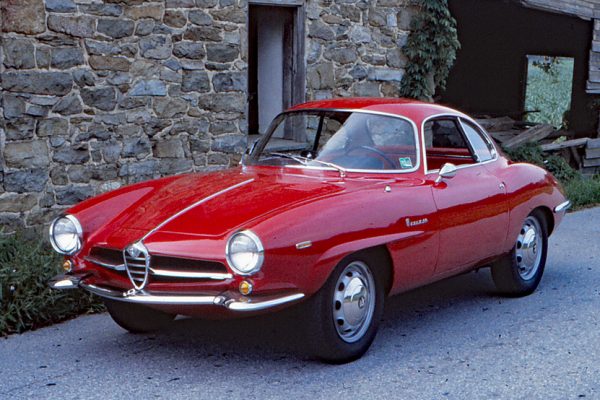Originally published in AutoWeek May 17, 1982
Iso Grifo; photos by John Matras
The Eagle. Symbol of flight and airborne grace. Bent, curved, hammered on an anvil of air. Daughter of the wind.
The Lion. Symbol of strength and mastery. Graceful only in the most brutish sense, beautiful only in the expression of power. Son of the earth.
Between them lies the bastard son, the Griffin. Half eagle half lion, protector of treasure and natural enemy of horses. Prancing or otherwise.
Renzo Rivolta could not have better named his two-seat GT. The sleek Bertone body wrapped around a Chevy small block is the automotive embodiment of the Griffin. Or as a say in Italy, the Grifo. It is the eagle and lion on four wheels.
The Iso Grifo, introduced in 1963, was not the Iso work’s first model. It had been preceded by the Rivolta, a pleasant Bertone-skinned and Chevy-powered four seater, and a decade earlier by the Isetta, which gained more fame when produced under license by BMW.
Surely responsible for much of the Grifo’s success is the classic Bertone a coachwork. Attributed to Giorgio Guigiaro, it is a familiar shape, well-proportioned in the long nose/fastback mode of the era.
The engine needs no introduction. It is pure U.S. of A., All-American, John “The Duke” Wayne. True grit. Purebred as a mongrel, twice is tough, and just as easy to get along with. Two versions of the 327-CID “Corvette” engine were available. According to the owner’s manual, these were the “H./Perf. Type” producing 300 BHP at 5000 RPM, and the “Sp./H./Perf. Type” churning out 350 BHP at 4800 RPM. Or to us Americans, these are the Chevy 327/350 engines. Pushrods and a Rochester four-barrel.
Giotto Bizzarrini was the match-maker for this union of the Lion and the Eagle. His background had included stints at Alfa and later Ferrari, where he worked on the 250 GT, the Testa Rosa and the GTO. For Iso he designed the Rivolta, from which sprang the chassis for the Grifo: double A-arms, springs and anti-rollbar upfront; in the rear a de Dion axle with twin trailing radius arms and a transverse link, all on coil springs. Disc brakes 11.5 inches in diameter in front, almost 11 inches in the rear, nearly large enough to be used as wheels on today’s subcompacts.
In size, the Iso Grifo is very close to a Corvette. All the critical dimensions—height, width, wheelbase—are within an inch, although the Grifo comes in a couple hundred pounds lighter. The grief oh is surely what must be called a front mid-engined car. The slight bias is 52% on the rear wheels, unusual considering that there is a Muncie four-speed made it to the rear of the engine (ZF five-speed or Powerglide three-speed automatic were options) instead of some Alfa-esque transaxle balancing things out at the rear.
Driving the Grifo only enhances its dichotomous aura. Entry is not particularly difficult despite the car’s lowness, thanks to the wide doors, and the seat cradles you like a giant hand. On the dash is a procession of Veglia instruments: Benzina, Olio, 320 KM/H speedometer with a red jewel marked Generat., Press., Olio, Giri X 1000, Acqua, Ampre and a clock.
A gauge freaks delight. Six toggles marked in Italian on the console are there, plus two unmarked. Sliding levers, again in Italian, provide climate control. Look around. There’s an imitation rear seat, right down to the bucket and seatback contours, but there’s not leg room even for a child. That’s okay. There’s hardly leg room for an adult up front; that is if he wants to reach the steering wheel. It’s the classic Italian driving position: Hands will bump thighs when cranking the big wood-rimmed Personal steering.
The Grifo we drove belongs to Dave Kinney of Great Falls, Virginia. It’s a ‘67 327/350, and it bumpty-rumps to life with a well-mannered impatience. It will idle day but would rather be doing other things.
Moving away from idle, the car shudders with an every throb of the engine. Like a lion arising from rest, the Grifo shows a bit of clumsiness in traffic. A Grifo behind an Oldsmobile diesel is a lion caged: Unhappy.
Turning onto the four-lane divided highway though is like opening the cage door. Too much throttle a bit too soon steps the limited-slip rear end out to one side, but ease off slightly and it walks back in without drama. Like it was planned. A quick check on the road fore an aft for Fairfax County’s Finest promises clear sailing, so the loud pedal goes down in second gear. The big broad nose rises ever so slightly as the lion roars, surprisingly, no, startling the occupants of the Chevette as it thunders past.
How fast? The speedo doesn’t work. A post check of “speed-in-gears” those says that the quick burst shot the Grifo past 110. Indeed, second gear is good for 92 mile-per-hour, third to 117 and fourth 262. Hoo boy. And appropriately, too. A Grifo took ninth overall and first in class at Le Mans in 1965.
A winding highway tests the Grifo’s handling. Car has a…substantial feel. There’s weight–this is no Lotus Elite–but it feels carried low. There’s little lean in the corners, the pavement patches and other assorted bumps are felt but don’t upset the Grifo’s arc. Coming up behind a 280Z produces a lot of eyeballs in the mirrors ahead, but the driver discreetly ignores the challenge of the Lion and Eagle behind. Well there’s awesome and there’s awesome.
And awesome the Grifo is. Leave the pedigrees and the bloodlines to dogs and horses. This hot-blooded hybrid has inherited the best of both parents. The Eagle. And the Lion.


















What Do You Think?
You must be logged in to post a comment.